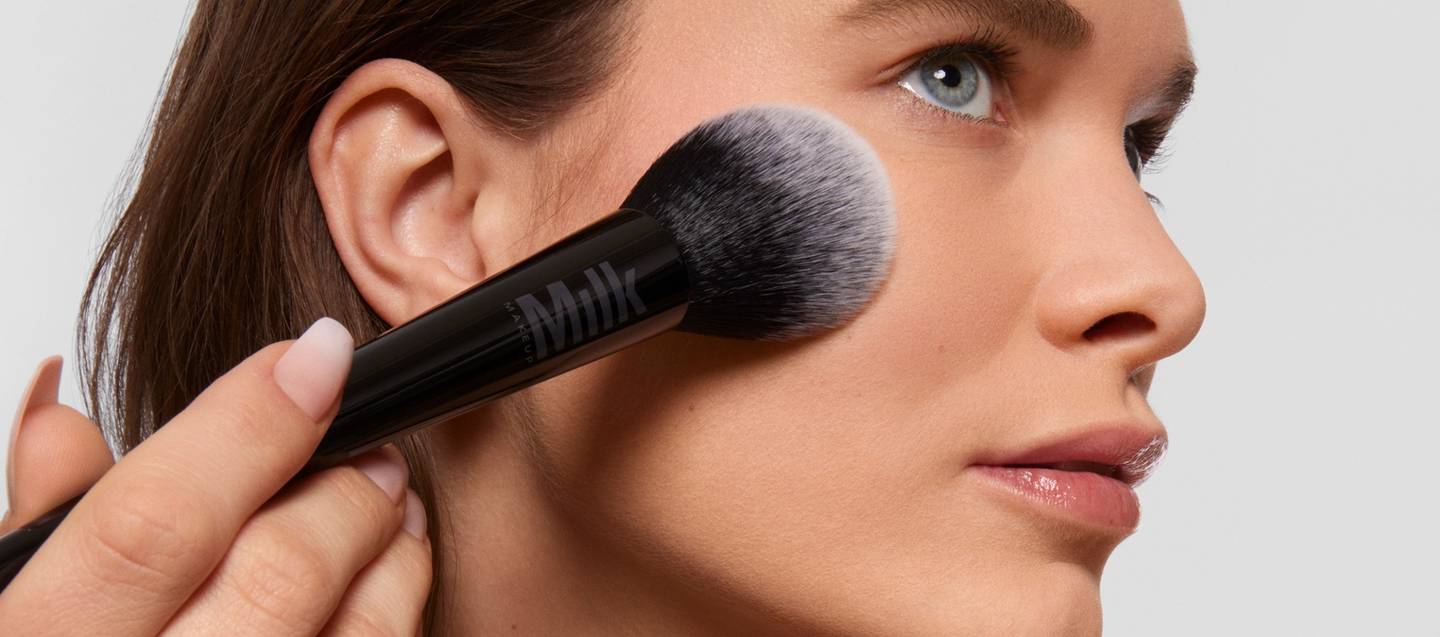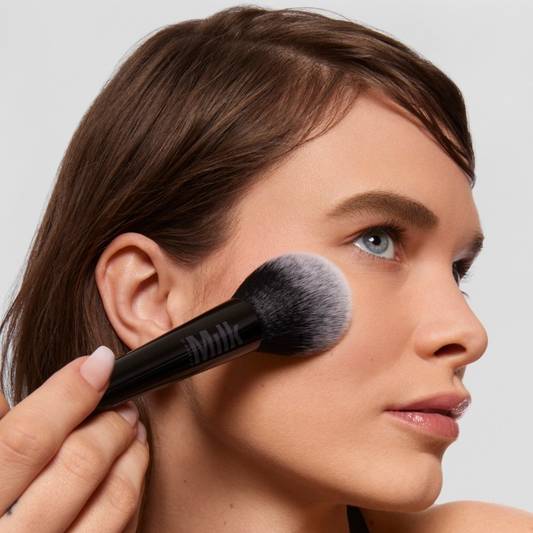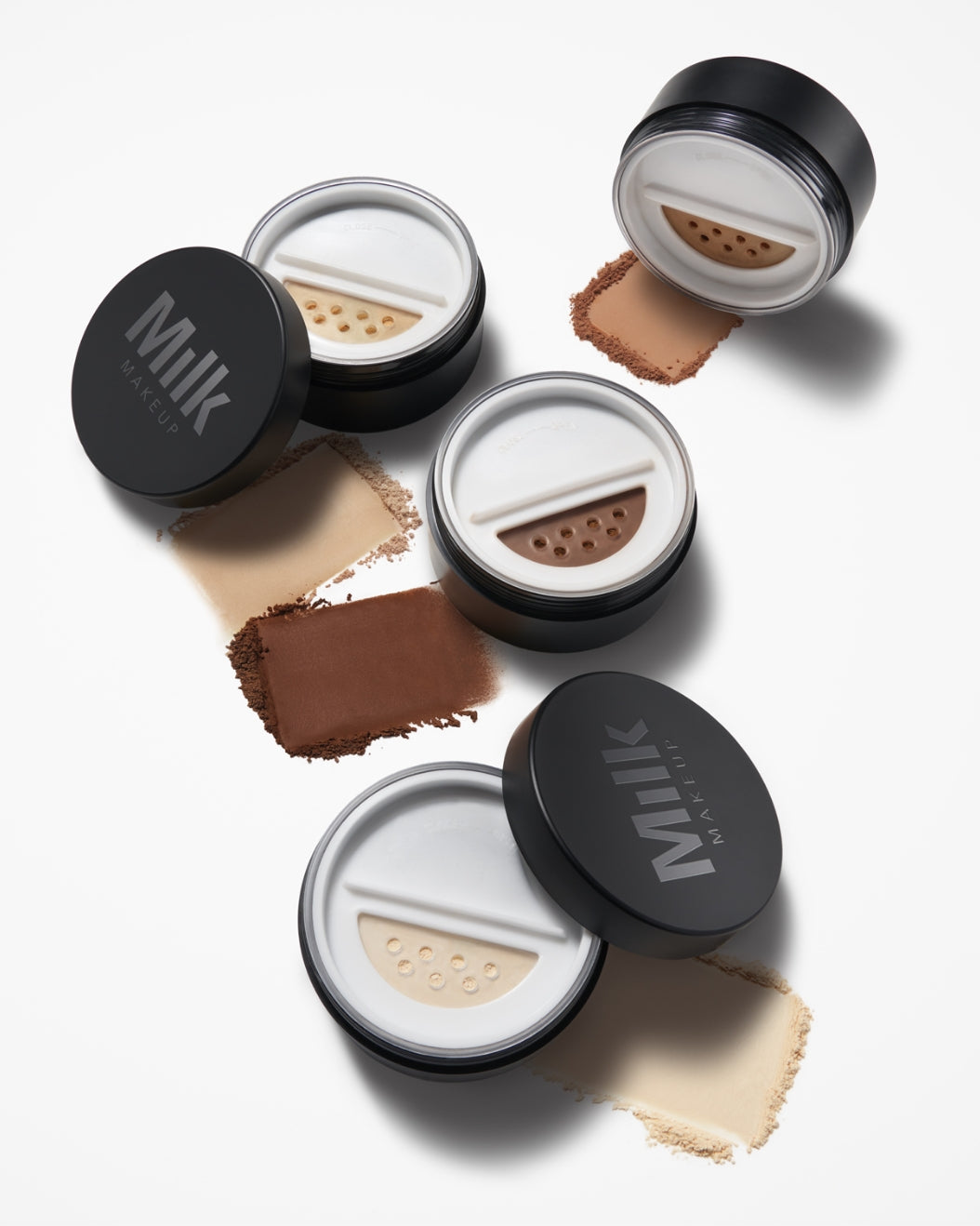Classic moment of makeup flashback: You’re having a night out with friends and you're taking photos. The camera clicks with a burst of light. You turn your phone around to look at the snapshot, only to see a powdery white cast on your face. That’s flashback—and we hate it for you.
If you use setting powder, you may have experienced makeup flashback before, and you’re not alone. Even celebrities with whole glam teams have fallen victim to this phenomenon, on the red carpet no less. But the good news is, it doesn’t have to be that way—makeup flashback is relatively easy to avoid.
We spoke to Sara Wren, Milk Makeup’s Director of Artistry, for her insight on what causes makeup flashback, how to prevent it from happening, and her best tips for using setting powder.
What is Makeup Flashback?
First things first, let's define makeup flashback. This term refers to the appearance of a white cast that looks like baking flour on your skin where makeup (such as setting powder, foundation, or concealer) was applied. It may be invisible in natural light, but it becomes really noticeable when you take a flash photo. Most of the time, it gives off an uneven makeup look that’s way too bright.
What causes makeup flashback?
“Typically, flashback is caused by too light of a powder or powder that has a high amount of silica in the formula,” says Sara. “Silica reflects light, so when the camera flashes, whether it’s a cell phone or studio lighting, it creates a white cast on the skin.” This also applies to other light-reflecting ingredients such as mica and talc.
What is talc and why is it used in makeup?
Talc is “a naturally-occurring mineral composed of magnesium, silicon, hydrogen, and oxygen,” board-certified dermatologist Blair Murphy-Rose, M.D., previously noted. What makeup has talc in it? Powder products like blush, eyeshadow, bronzer, and, yes, setting powder. In addition, it’s commonly used in hygiene products such as baby powder and deodorant as well as liquid foundation and dry shampoo.
Although talc has perks such as giving skin a smooth, cake-free matte finish, and it's well-tolerated by most skin types, it’s known to have some negative qualities, too. Is talc bad in makeup?Well, it’s not great. Because it’s so absorbent and helps skin wick away oil, it tends to be “excessively drying to some,” Dr. Murphy-Rose notes. “This could exacerbate skin conditions associated with dryness like eczema and other skin hypersensitivity conditions.” Talc can also look and feel chalky on your face and cause makeup flashback since it reflects light.
These days, the topic of safety in talc has been surfacing. There’s currently no definitive answer as to whether talc can be harmful in cosmetics, but there have been proven cases of talc being contaminated with asbestos and asbestos fibers, a mineral substance linked to cancer.
How to avoid makeup flashbackTo avoid makeup flashback, choose your products wisely. Our talc-free, clean, and vegan Pore Eclipse Matte Translucent Setting Powder was designed to prevent flashback while boasting other skin benefits including minimizing the look of pores, smoothing skin texture, and evening it out. You can thank ingredients like niacinamide and bakuchiol for that. Instead of talc, we use hydrating lentil extract, a powdered version of the mineral-rich legume found in soups that helps absorb oil, fight shine, and give you that mattifying effect. Lentil extract is also rich in vitamin B5 to help soothe and smooth skin. |
|
|
Sara notes how Pore Eclipse Powder makes your skin look airbrushed. It can be applied with a brush, dry sponge, or the very popular triangle velour puff, she says. “The key with powder is ‘less is more’. Too many layers of powder can make skin look dull or dry. While this isn’t a drying formula, if it is applied too heavily it will look dry,” says Sara, who recommends picking up the powder on the brush and tapping off any excess before taking the brush to your skin. Apply it all over your face after putting makeup on and spot use on your T-zone or areas prone to shine. When baking (applying concealer and powder under your eyes for a crease-free finish), be sure to prep your under eye area with hydrating formulas like Hydro Grip Eye Primer and Future Fluid All Over Cream Concealer. Sara says, “These formulas help smooth texture, brighten, and cover the under eye area. They work beautifully with the Pore Eclipse Matte Translucent Setting Powder.” Keeping skin mattified with the whole Pore Eclipse Fam (including the Mattifying Primer) is ideal for avoiding any “hot spots” or flashback in photos, says Sara. “I suggest when using creamy and hydrating products, if you are going to be photographed, it should be set with either Matte Setting Spray, Matte Translucent Setting Powder, or both layered together,” she adds. |
 |
How do you fix makeup flashback?
Let’s say you’re reading this after realizing your photo came out with, sigh, makeup flashback. At this point, the easiest way to fix it is to change your lighting. “If you don’t have time to reapply makeup, avoid direct flash photography,” says Sara. “Go towards natural lighting for a softer, more forgiving look. No flash means no flashback.”
To test and make sure you don’t have a flashback moment before going out, use the front-facing camera on your phone and turn the flash on. “Experiment with taking photos in a few different light settings (indoor, outdoor, and a dark room),” says Sara. “This will allow you to see how the makeup will look and perform in different settings.”
And there you have it. Everything you need to know to put makeup flashback behind you, once and for all.
Meet the Expert
Sara Wren (she/her) is the Director of Artistry at Milk Makeup. In her role, she does all the makeup artistry and direction for our Milk Makeup global campaigns, educates the staff and field team on application methods, stars in the brand’s social media videos, and travels to different markets spreading Milk Makeup’s good vibes. When she’s not on set, Sara loves experimenting with DIY hair colors, eating tacos, watching basketball, and scouring for vintage cosmetics to add to her impressive collection.



-%E2%80%A2-Instagram-photos-and-videos-v1713892805204.png?309x309) "
"

















